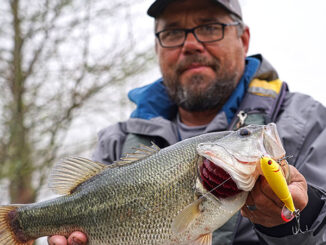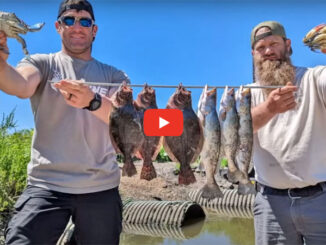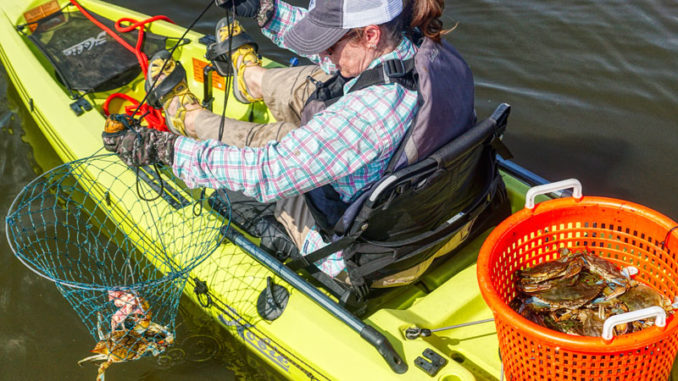
Pull. Pull. Pull…. That chant was repeated dozens of times as crab nets were hoisted from the bottom of a local bayou. As the nets come up, the crabs try to escape, so the harder you pull, the force of the water helps keep them from getting out of the net. There’s nothing worse than seeing a No. 1 male launch himself over the rim just before you can get him in the basket.
Kayaks are usually the last vessel that comes to mind as a crabbing boat; however, with a little planning, they make it easy and exciting.
Making kayaks looking like miniature versions of what you’d see on Deadliest Catch, two dozen crab nets were stacked on the bow, and foam bait trays filed with cut chunks of turkey necks were at the ready.
Bait up beforehand
It is easier and saves time if you bait-up for the first round before you leave shore. Neatly stack the nets by rotating where the corks sit so that they do not sit directly on top one another. This helps keep the stack level and more compact. Although you can use more, two dozen nets are easily managed and make for optimum soak time between running your strings.
Try to pick a day with good tidal movement. Crabs feed better when the water is moving, and it helps disperse the scent of your bait to lure them to the nets.
Store-bought chicken and turkey necks are inexpensive and readily available. I prefer turkey necks, because they are larger and can be bought pre-cut into perfect-size portions. Another advantage of turkey necks is that the bait pin in the net can be inserted through the middle of the bone itself, which helps feeding crabs from stealing it.
Fish heads are another good bait. When cleaning speckled trout, I pack all my heads into gallon ziplock bags and freeze for later crabbing use. Simply mark the number of heads on the bag so you’ll know how many baits you have. Fish heads should be pinned through the eyes to keep them in place.
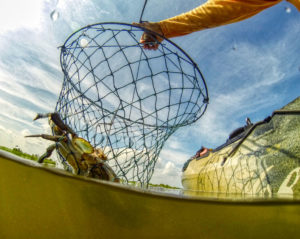
Insider tip: Don’t use redfish
Don’t use redfish heads. As one of their natural predator, crabs won’t go anywhere near a net baited with a redfish head. Using quality nets is a must. Get some that are coated with trawl dip and use quality stainless-steel bait pins. I prefer about 10 feet of line and colored corks to identify your nets as well as make them easier to see as you run your string.
When setting out the first string, start downwind/downcurrent as you move along. The reason for this is evident as you go back to pick up the first nets. It is much easier to use the wind or current as a brake to paddle/pedal into perfect position. You are able to pull the nets straight up without going past them. Keep a basket in the rear tankwell so the nets can be pulled and the crabs emptied by simply turning around in your seat.
Make sure the basket has a solid lid to keep the sun off of the crabs and keep them from crawling out as the basket fills up.
Get a quality pair of stainless crab tongs to help wrangle any crabs that fall into the cockpit. There are no more tense moments than when angry crabs are scurrying near your feet or worse, your nether region. Keep your tongs attached to a leash, as they are invaluable and you do not want to drop them overboard.
Keep your distance
Keep about 30 yards between nets. This helps you thoroughly fish an area without the nets competing against one another. If the nets are pre-baited, it won’t take long to get that first string set out.
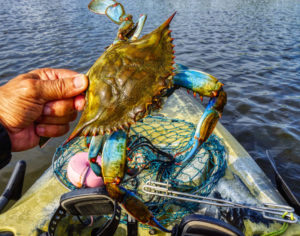 Let the nets soak a good 15 to 20 minutes before making the first pick-up. After that, you should be able to run them in a continuous rhythm as the time taken to remove crabs and re-bait when necessary allows for ample soak time during each run. Bait is cheap. Make sure to re-bait when it gets well-eaten or washed-out looking. Fresh bait can make the difference between having several crabs in a net versus an empty one.
Let the nets soak a good 15 to 20 minutes before making the first pick-up. After that, you should be able to run them in a continuous rhythm as the time taken to remove crabs and re-bait when necessary allows for ample soak time during each run. Bait is cheap. Make sure to re-bait when it gets well-eaten or washed-out looking. Fresh bait can make the difference between having several crabs in a net versus an empty one.
Make mental notes of which nets seem to be doing better and adjust your string as you go. A depth finder is great for judging the bottom and finding where you want to set the nets. As you progress, see what depths seem to be doing better than the others. Move your nets accordingly and don’t be afraid to stack them and move to a different location if necessary.
Most areas of south Louisiana saltwater or brackish waters have good populations of crabs. They even tolerate fresher areas fairly well. Look for areas where folks regularly crab off the side of the road and try the opposite bank where there is no land access.
Look for crab traps
Crab traps are a sure sign of a good area as commercial crabbers know where to set them. However, to avoid confrontation, do not set your nets right next to someone’s traps. Try the other side of the bayou or spread the nets out between traps.
When the day is done, place the crabs in a cool, shady place while waiting for your boiling pot to get going. Take that time to spread out each net on the driveway and thoroughly hose them down. Let them dry in the sun and then stack for the next outing.
It might not be Alaska or the Bering Sea, but you will feel like Captain Sig when you take your kayak on a Deadliest Catch adventure to a local bayou and come home with a basket full of delicious Louisiana blue crabs.
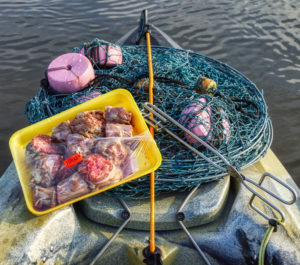
Legal Recreational Crabbing With Nets:
There is no license required for any person using crab nets or lines. Anyone harvesting crabs on WMAs or refuges must possess either a basic recreational fishing license or Wild Louisiana Stamp.
There is no recreational minimum-size limit for blue crabs. The possession limit is 12 dozen crabs, per person, per day. Certain WMAs and state and federal refuges may have different possession limits.
No person may possess adult female crabs in the berry stage (i.e., carrying the eggs or young attached to the abdomen). All crabs taken in the berry stage must be returned immediately to the waters.
The season is open year-round, except for certain announced closures. There will be a Sept. 9-Oct. 13 fall prohibition on the recreational take or possession of mature female blue crabs in the fall of 2019. However, this prohibition could be removed depending the results of the 2019 blue crab stock assessment. Please make sure to check the regulations for updates.

